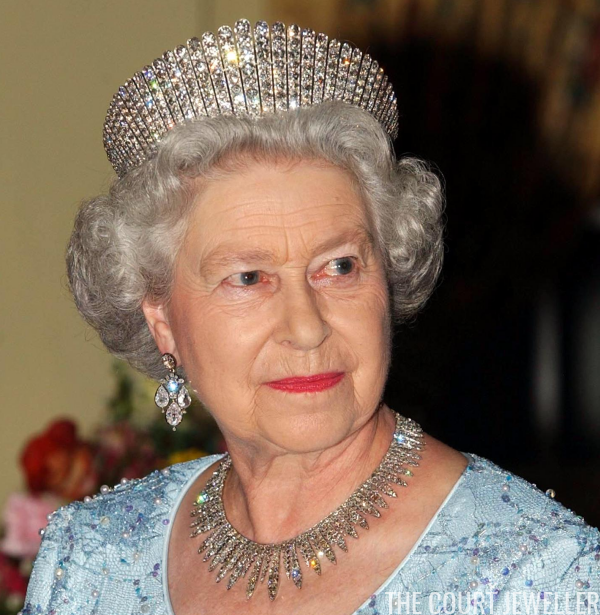 |
| Queen Elizabeth II wears Queen Alexandra’s Kokoshnik (ARTHUR EDWARDS/AFP/Getty Images) |
There are so many reasons to love Queen Alexandra’s Kokoshnik. It’s an utterly classic tiara from a design perspective. It’s a literal wall of diamonds. It has a fascinating, Romanov-related backstory. Let’s take a deep dive into this piece’s intriguing history today, shall we?
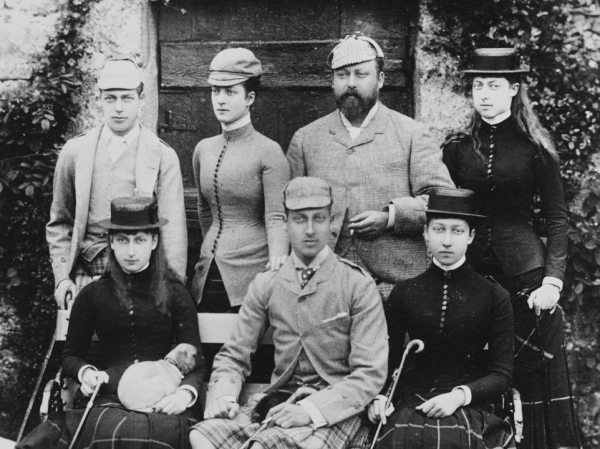 |
| Bertie and Alexandra, then Prince and Princess of Wales, with their children. ca. 1885 (Wikimedia Commons) |
In 1888, the Prince and Princess of Wales (later King Edward VII and Queen Alexandra of the United Kingdom) celebrated their silver wedding anniversary. The milestone was an important marital mileston — and an important opportunity for courtiers to gain favor by offering the couple spectacular presents. But those kinds of gifts didn’t come cheap, and aristocrats in the late nineteenth-century weren’t necessarily flush with cash; remember that many of them had already begun marrying American heiresses to help prop up their sagging fortunes.
One group of aristocratic women found a simple solution: they pooled their resources, forming a committee called the “Ladies of Society.” The committee was led by four prominent women: the Marchioness of Salisbury (who was the wife of the Prime Minister); Maria, Marchioness of Ailesbury (who was a supporter of the opposition Liberal Party); the Countess Spencer; and the Countess of Cork. Under their leadership, the committee raised the necessary money to buy a major piece of jewelry for Alexandra. To make sure she’d like what she was given, they asked her directly for input.
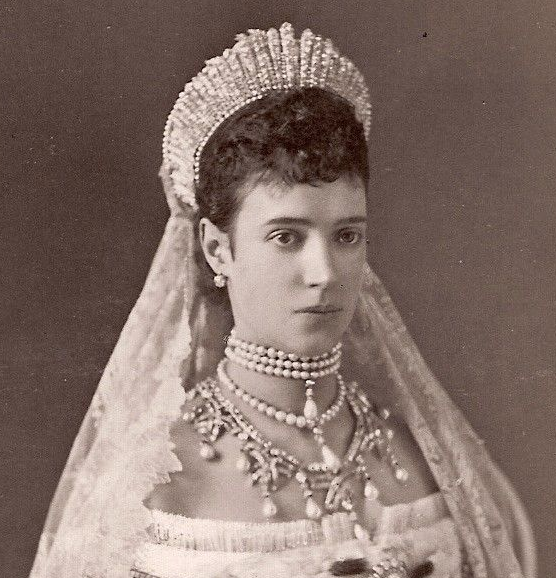 |
| Empress Marie Feodorovna of Russia wears her diamond kokoshnik |
Alexandra knew precisely what she wanted: a tiara just like one worn by her sister, Empress Marie Feodorovna of Russia. Marie Feodorovna frequently wore a grand diamond fringe tiara shaped like a kokoshnik, which is a halo-shaped headdress worn by Russian women. To emphasize and reinforce the kokoshnik shape, the Empress wore her diamond tiara with a stiff fabric backing.
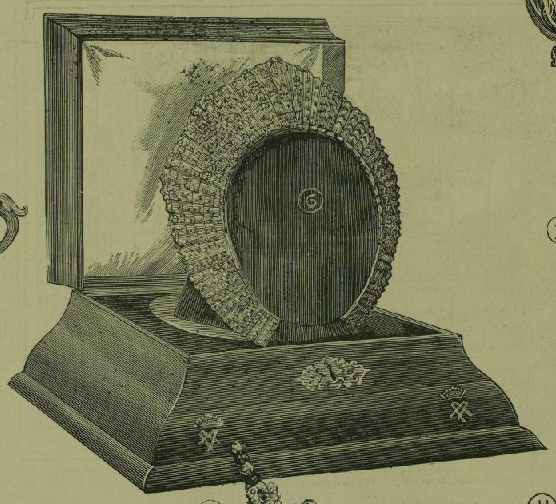 |
| The kokoshnik depicted among Bertie and Alexandra’s anniversary presents in the Illustrated London News, 1888 |
The Ladies of Society turned to the crown jeweler, Garrard, to make a tiara similar to the Russian piece. The firm crafted a diadem of white and yellow gold set with diamonds. Like Marie Feodorovna’s tiara, the piece was made of individual pavé-set bars, though Alexandra’s fringes were more rounded at the tip. Alexandra’s kokoshnik featured 77 of these fringe pieces, and the entire tiara was packed with more than 400 diamonds. Even better, it was convertible, able to be taken off of its frame and worn as a fringe necklace. The jeweler also supplied a fitted box for the piece, plus an album with the signatures of each woman who had donated money toward the gift. The final cost was just around £4,400.
But, as is often the case when many voices are involved in making a decision (or buying a very big royal gift), the committee began squabbling about who was going to get to present the tiara to the Princess. Georgina Salisbury assumed that, as the wife of the prime minister, she would be the natural choice to present the gift. But Maria Ailesbury contended that she was the one who came up with the idea in the first place, and besides, she was one of the eldest and most influential women in the group. The disagreement was a microcosm of the politics of the day, as Salisbury and Ailesbury sat on opposite sides of a major issue: Home Rule for Ireland.
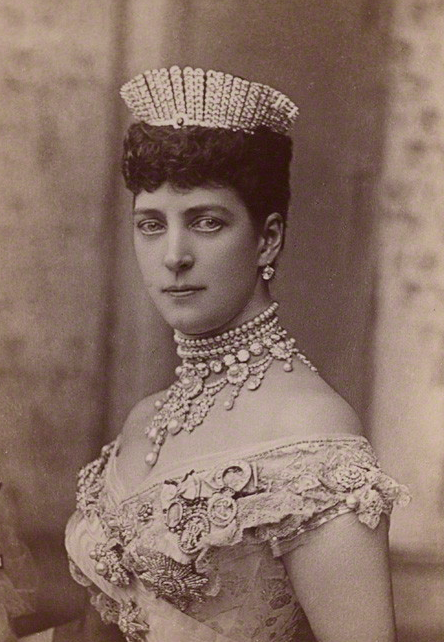 |
| Alexandra wears the tiara at the wedding of the Duke of York, 1893 |
Lady Ailesbury prevailed, and she presented the tiara to Alexandra at Marlborough House on the morning of March 10, 1888. The festivities were more subdued than intended, because Emperor Wilhelm I of Germany (the father-in-law of the Prince’s elder sister, Victoria) had died the day before. The entire royal family, dressed in deep mourning, received the gift-bearing guests. Lady Ailesbury read an address on behalf of all 365 women who had subscribed to the gift before presenting the tiara to the Princess.
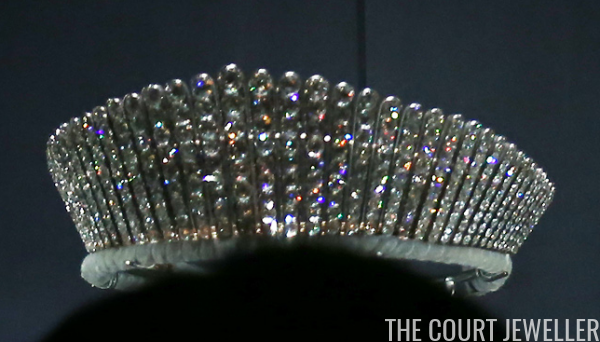 |
| The kokoshnik on display at Buckingham Palace in 2015 (Peter Macdiarmid/Getty Images) |
About a month after the presentation, the Sydney Morning Herald published an account of the anniversary reception. They described the tiara as follows: “The diamond tiara which the ladies of England presented to the Princess of Wales, and which is an exact copy of one possessed by her sister, the Empress of Russia, is not a particularly beautiful object. It is oval in shape, and can be worn either on the head or round the neck. It is composed of a series of straight spikes, the longest being in front, and the size diminishing towards the back. Each spike consists of some six or eight diamonds, the stones being of good quality, and those in front of large size.”
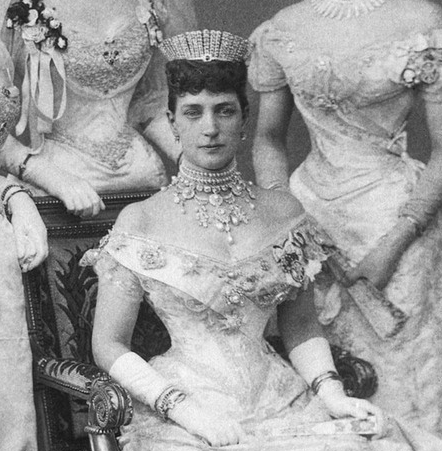 |
| Alexandra wears the tiara at the wedding of the Duke of York, 1893 |
One of the tiara’s first appearances at a major royal occasion came a few years later, when Alexandra wore the diadem at the 1893 wedding of her second son, the Duke of York (later King George V), and Princess Mary of Teck. In portraits taken on that day, the flexibility of the tiara is apparent; the fringes are not bunched tightly together, and spaces are visible between the bars. Alexandra appears to have used another jewel, possibly a bracelet, to help gather the fringe together.
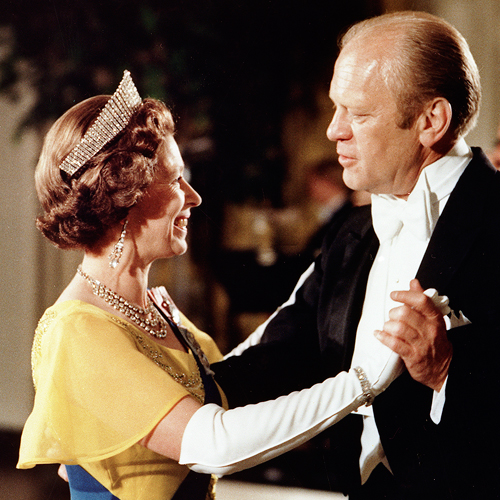 |
| Queen Elizabeth II wears the kokoshnik in its present form at the White House in 1976 (Wikimedia Commons) |
Two years later, the problem of the tiara’s base was solved permanently when Garrard constructed a new self-adjusting frame for the piece. At some point, Alexandra also had additional alterations made to the tiara. Hugh Roberts notes (without offering a date) that 16 of the smallest diamond bars were removed at some point after the tiara’s creation. The current tiara is made of 61 graduated bars, set with a total of 488 diamonds. Alexandra became queen consort in 1901, and a newspaper survey of her jewelry collection shortly afterward described the kokoshnik as “among the handsomest of her jewelry possessions.” Press reports often described the kokoshnik as a “Russian tiara” or a “sunray tiara.”
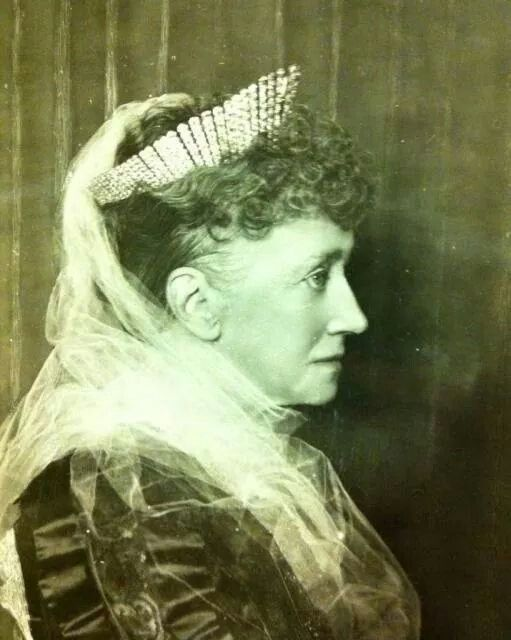 |
| Queen Louise of Denmark wears the tiara, ca. 1890s |
Work by posters at the Royal Jewels of the World Message Board has helped to show that Alexandra loaned the tiara to at least one person during her lifetime. Between 1888 and 1898, Alexandra’s mother, Queen Louise of Denmark, was photographed in the tiara. (I think the photograph was taken before 1895, before the new frame was made, as the bars of the tiara are not tightly bunched.) The profile portrait was a study taken for the artist Josef Theodor Hansen. He sculpted a relief of Queen Louise wearing the tiara; today, the art piece is in the collection of the Amalienborg Palace’s museum in Copenhagen.
When Queen Alexandra died in 1925, the kokoshnik was inherited by her daughter-in-law, Queen Mary. (A fitting choice, since it was famously worn by Alexandra at Mary’s wedding.) Queen Mary already had two other fringe tiaras in her possession — her own, newly-created diamond fringe, plus the diamond fringe that had belonged to Queen Adelaide — but the kokoshnik nevertheless became an important piece in Mary’s jewelry box. She posed for a portrait by photographer Hay Wrightson in 1934 wearing the kokoshnik with another of Alexandra’s jewels, her diamond collier resille. As Hugh Roberts notes, Mary also wore the tiara in portraits taken to mark her 80th birthday in 1947.
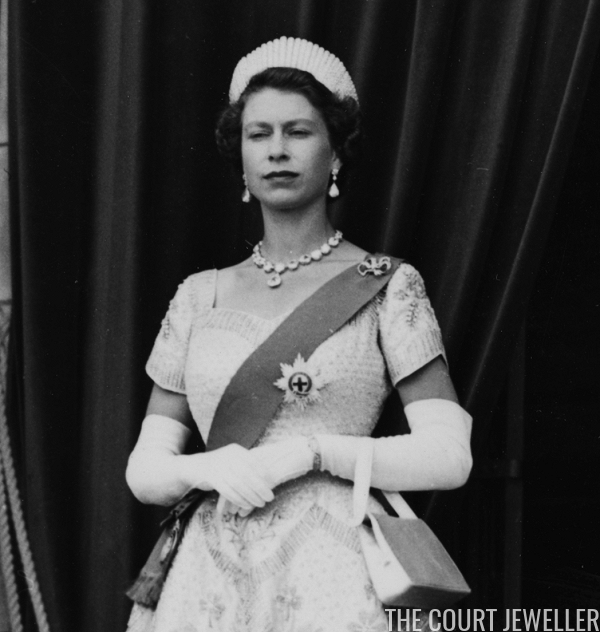 |
| Queen Elizabeth II wears the kokoshnik at the opening of parliament in Melbourne, 1954 (Fox Photos/Hulton Archive/Getty Images) |
Queen Mary died in 1953, and along with most of the rest of her property, she bequeathed the tiara to her granddaughter, Queen Elizabeth II. The piece quickly became a central part of Elizabeth’s jewelry collection. She wore it on multiple occasions during her Commonwealth Tour in 1953-54, including the opening of parliament in Melbourne. During the 1957 tour of Canada and the United States, the Associated Press described the tiara as “a rather heavy headdress” and “a blaze of diamonds in a sunray pattern.”
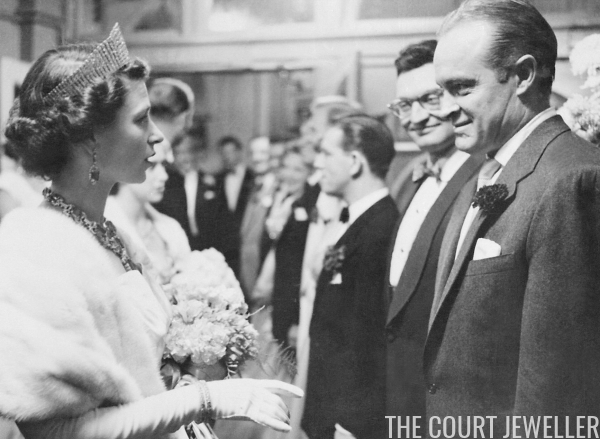 |
| Queen Elizabeth II wears the kokoshnik with the Brazilian aquamarines while meeting Bob Hope (STR/AFP/Getty Images) |
Along with the Girls of Great Britain and Ireland Tiara, the kokoshnik is one of the few tiaras that the Queen has worn consistently throughout her entire reign. It has appeared on foreign tours and visits, at royal premieres and performances, and at state banquets both in Britain and abroad.
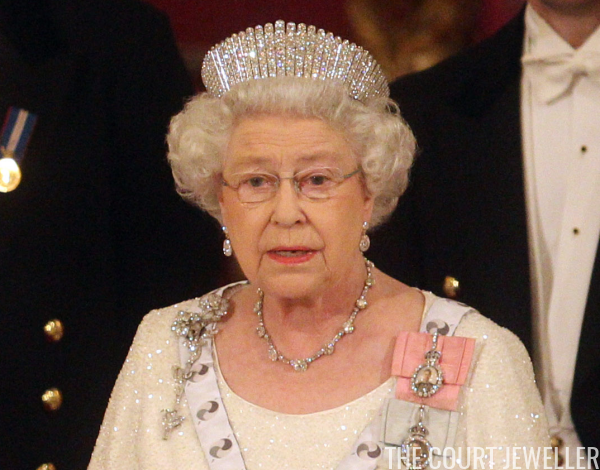 |
| Queen Elizabeth II wears the kokoshnik during the South African state banquet in 2010 (LEWIS WHYLD/AFP/Getty Images) |
The all-diamond tiara has proven a versatile part of the Queen’s collection, partly because it pairs so well with numerous other gemstones. Roberts correctly notes that Elizabeth has often worn it with her diamond festoon necklace, but she’s also paired it with numerous other necklaces, including the Coronation Necklace, her v-shaped ruby and diamond necklace, Queen Victoria’s Golden Jubilee Necklace, the Brazilian aquamarine necklace, the George VI sapphires, and — appropriately — Queen Alexandra’s Dagmar Necklace.
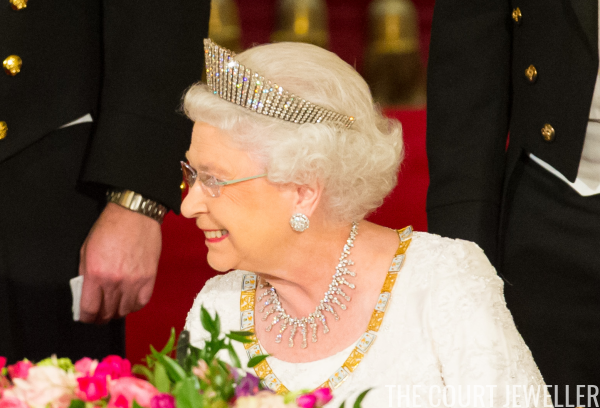 |
| Queen Elizabeth II wears the kokoshnik at the Mexican state banquet in 2015 (Dominic Lipinski – WPA Pool /Getty Images) |
We most recently saw the tiara on the Queen in public during the Mexican state banquet in 2015. It’s sometimes difficult to imagine some of the Queen’s tiaras being worn by future generations of royals, but the simple, classic design of this piece makes it feel just as modern now as it did more than a century ago. I can see Windsor women happily wearing this halo-shaped blaze of diamonds for years to come.
Leave a Reply